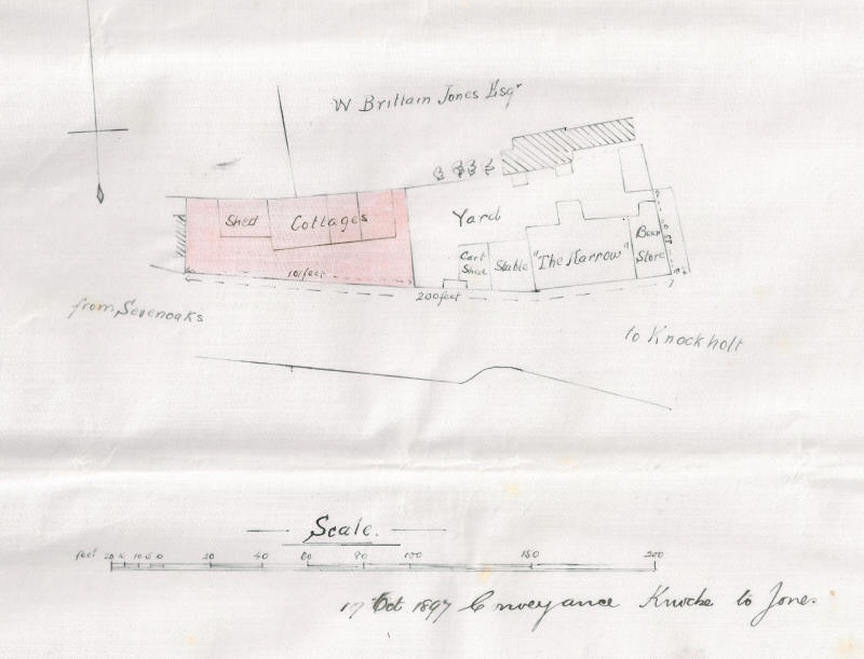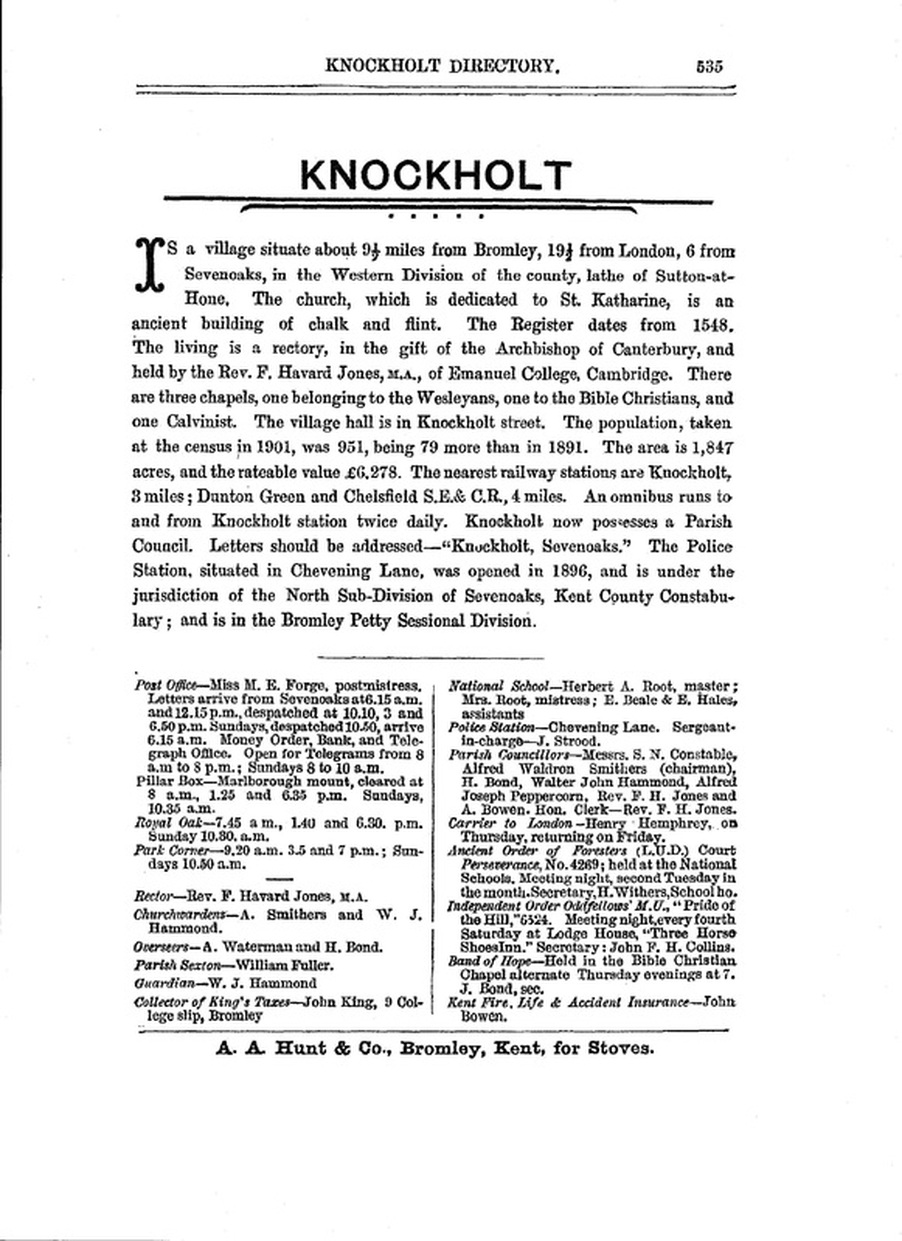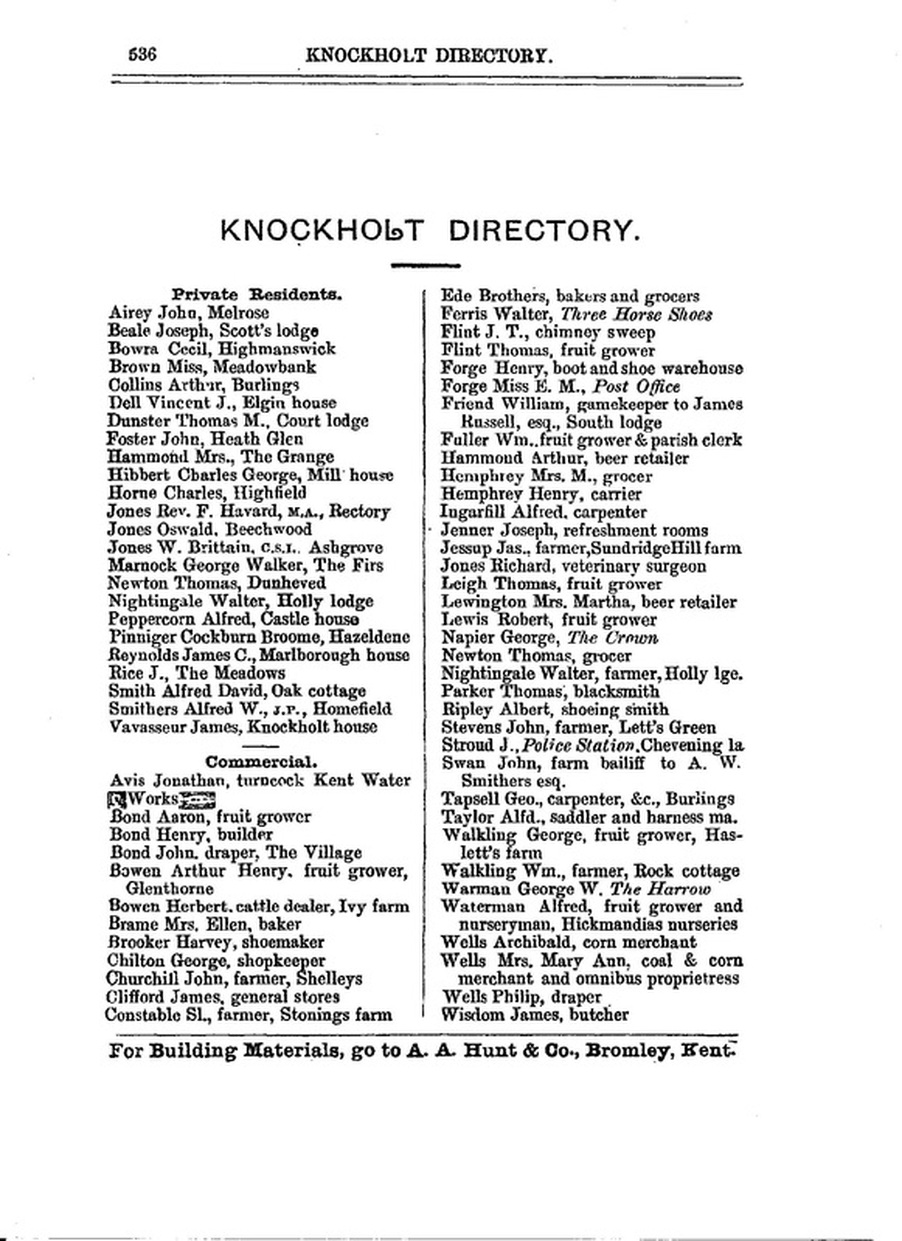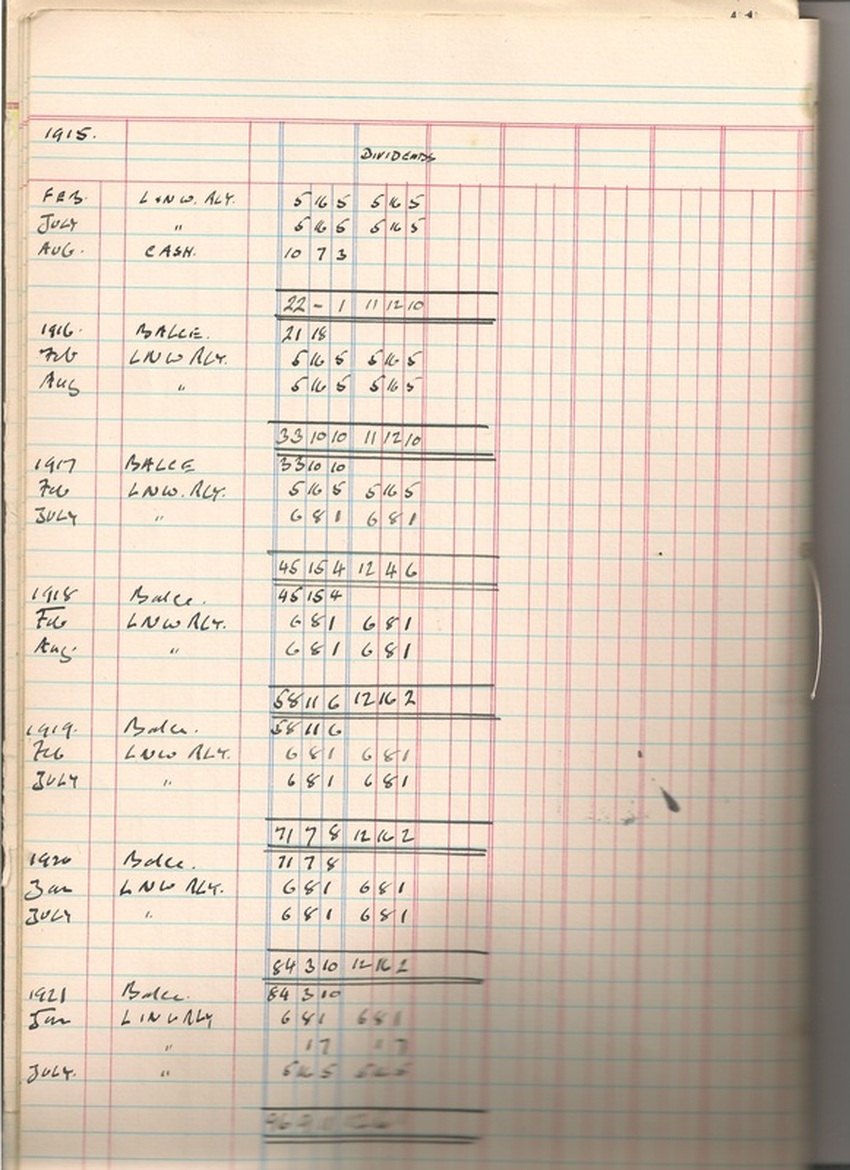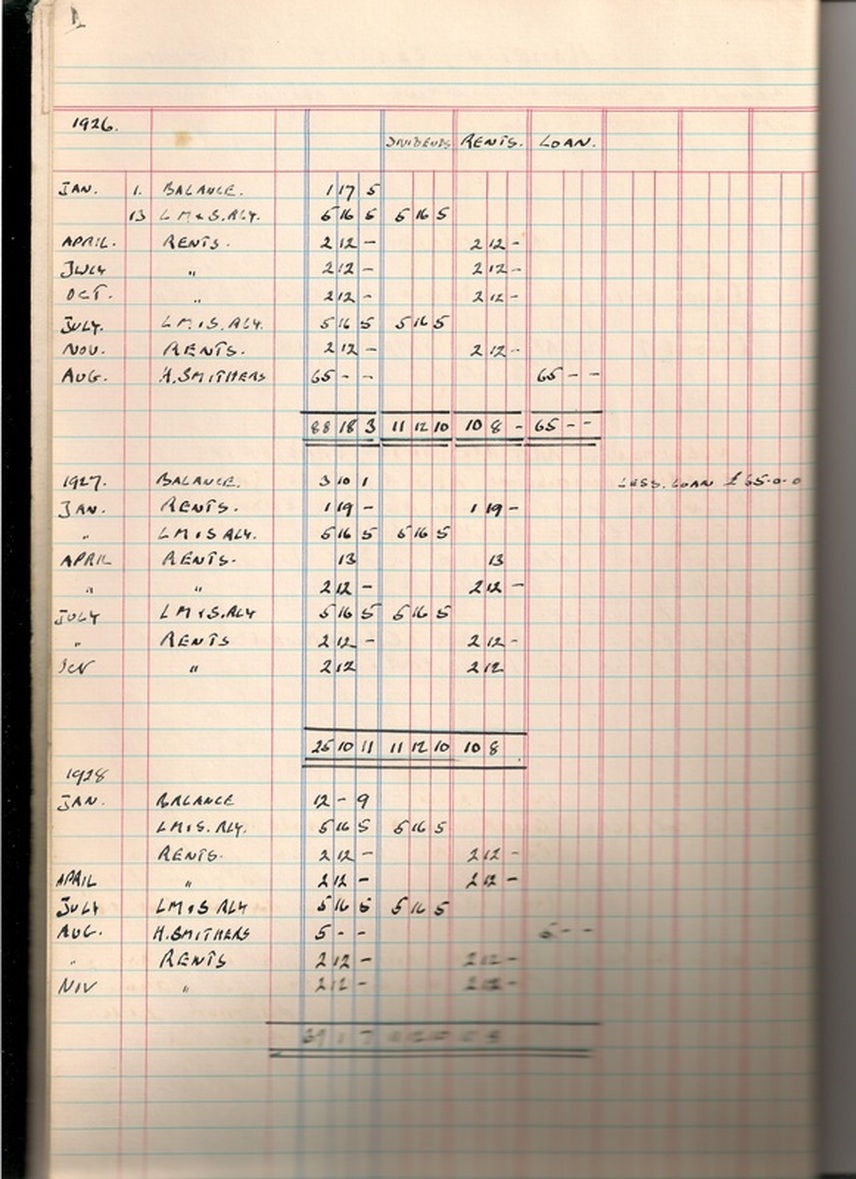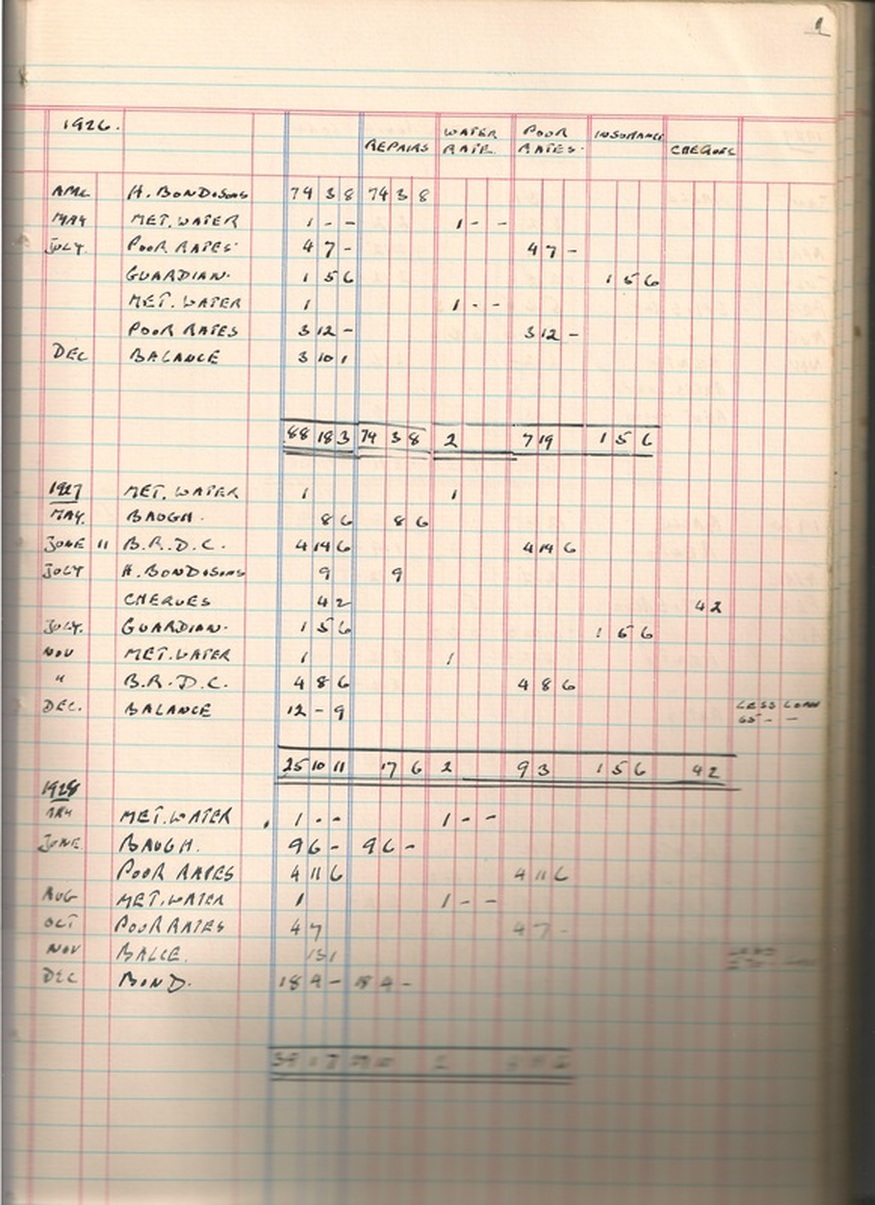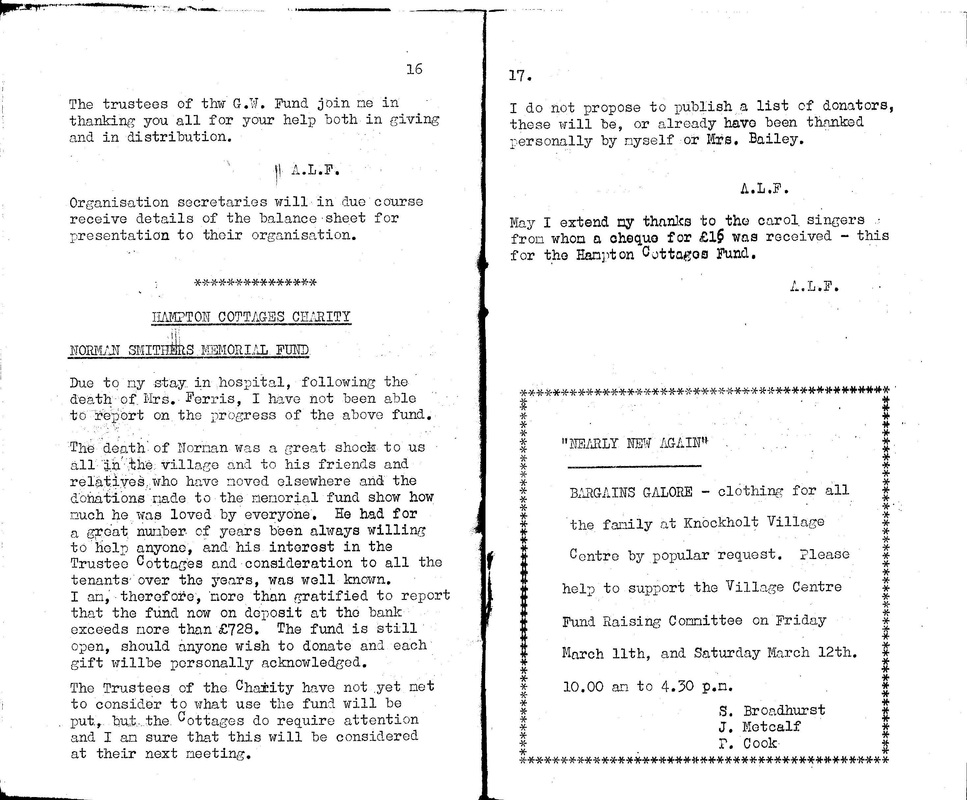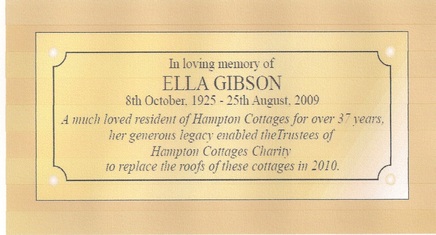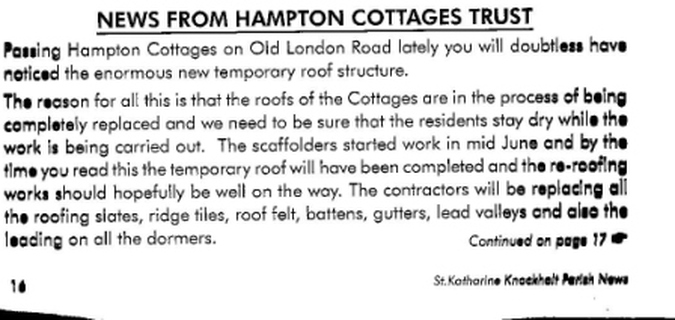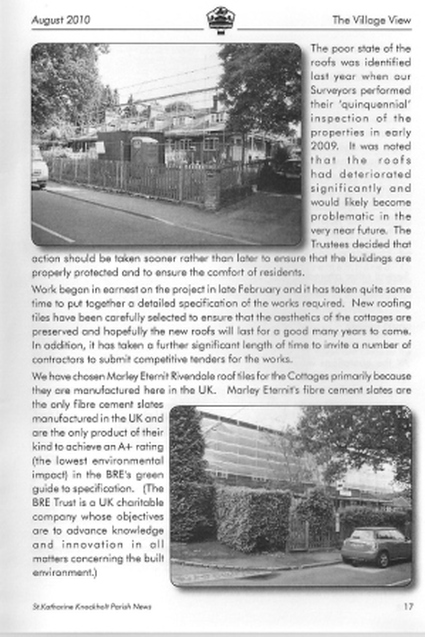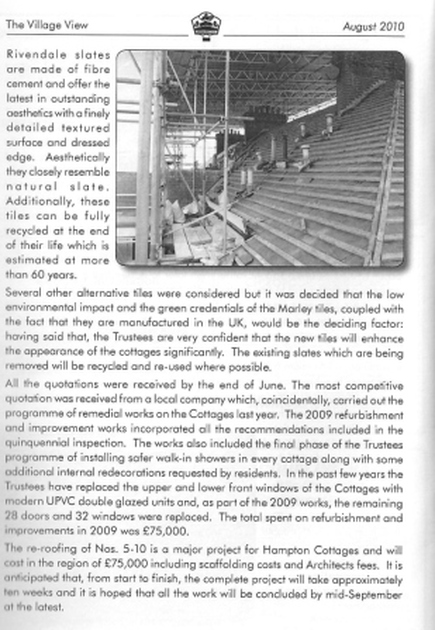HISTORICAL INTEREST
This page includes some items of historical interest.
1. Old site plans
2.Frank Bond (Builder of Hampton Cottages)
3. The Bromley Directory of 1905
4. Overseers of the Poor
5. First Hampton Cottages Accounts ledgers
6. Financial situation - 1974
7. Miss. Ella Gibson
8. Professor Sir David Waldron Smithers
9. Hampton Cottages - recent past residents
10. August 2010 Parish News article
11. The story behind the Knockholt War Memorial - follow this link:
http://www.kentfallen.com/PDF%20REPORTS/KNOCKHOLT.pdf
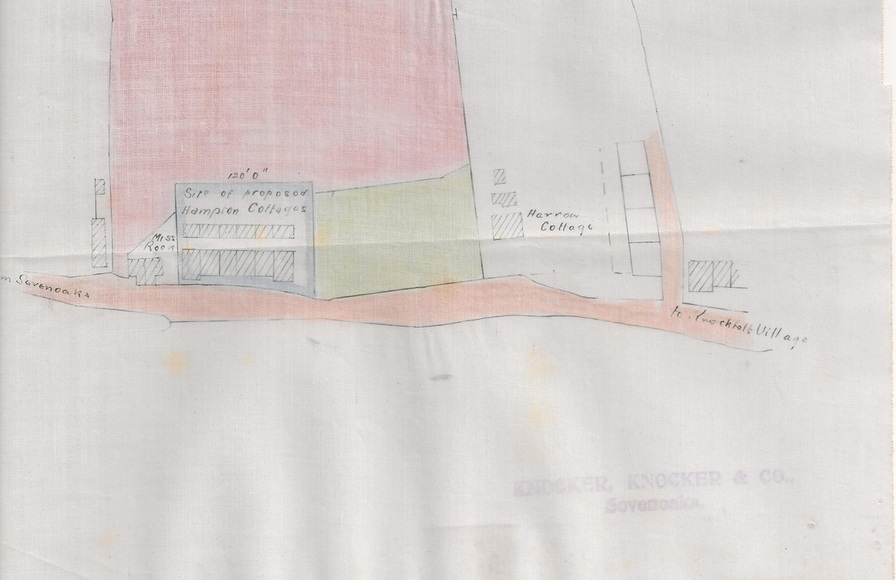
Plan showing land purchased by the Executors. of Wm. Brittain Jones in June 1914 & destined for the construction of 5 - 10 Hampton Cottages. It appears from this original plan that the cottages were to be built much nearer to the road and that they were to have "outhouses" at the rear similar to those of Nos. 1-4 presumably for a similar use as toilets. To the right of the map can be seen the four allotments next to the trackway (leading to Ashtree Cottages) which were used by the residents of 1 - 4 for many years - these now form part of the garden of "Hillcrest". (NB: Evidently not to scale).
Frank Bond
Long time Knockholt resident Mr. Frank Bond was the builder of 5 - 10 Hampton Cottages. He lived at that time at Grove End, Harrow Road, Knockholt which is more or less next door to 1 - 4 Hampton Cottages.
He was interviewed in 1970 and his memories provide a fascinating insight into the history of the village. His father Henry Bond was involved in the building of 1-4 Hampton Cottages and, as can be seen from the accounts shown below, payments were made in April 1926 to H. Bond & Sons which was the family business.
Reproduced here are a couple of particularly interesting and pertinent paragraphs from that interview..........
He talks about the Harrow Inn having been a Post House before Hampton Cottages were built. He says, "The Harrow is older than this house (Grove End). It used to be a Post House at one time. Where the Hampton Cottages are now are the first four (cottages) where the Post Boys rooms which were pulled down as recently as I suppose 1905".............
" Of course Mr Brittain Jones who lived at Ash Grove, he was a retired Indian Civil Servant. He was CSI – Companion of the Star of India. He had Ash Grove more or less rebuilt. We did it in fact. That was the first job I worked on when I left school. He built these four Hampton Cottages and left money for a further six. He was buried in Knockholt churchyard. He’s got a tombstone under the yew tree near the war memorial. He was a wonderful man.............."
" I never had any spare time as a lad! I used to play cricket as a boy and as a young man but never had the time for it. We had the garage and that was always busy at weekends and I used to work in the building trade as well. I went all through the building trade from A to Z. Every job was there. Eventually I built the six Hampton Cottages up the road here and several other buildings after my Dad got past it".
The full interview, published on the website of Knockholt Parish Council, makes fascinating reading.
The interview is available by cutting and pasting the following link:
http://www.knockholtparish.org.uk/reminiscences/bond3mar1970.pdf
Also of historical interest and containing mention of both Frank Bond and Hampton Cottages are the reminiscences of Mrs. Alma Saker dated March, 2010 also published on the website of Knockholt Parish Council:
http://knockholtparish.org.uk/reminiscences/alma-saker9apr10pic.pdf
========================================================
Knockholt History
Below is an excerpt reproduced from The Bromley Directory of 1905. It makes fascinating reading (particularly for those who have lived in the village for many years) and gives an insight into all the various types of commercial enterprises which existed in the village at that time (refreshment rooms, pubs, beer retailers, fruit growers, bakers, shoemaker, grocers, cattle dealer, veterinary surgeon, blacksmith, farmers, saddler and harness maker, corn merchants, coal merchants, draper, carpenter, butcher, chimney sweep etc.) . It also shows the names and addresses of Knockholt's most notable residents of the day. Note the inclusion of our founder and benefactor William Brittain Jones Esq., C.S.I of Ashgrove and Henry Bond, Builder (in the Commercial Section, as a Parish Councillor and as an Overseer and some years later as a District Councillor). The complete Directory can be viewed at the following link: http://archive.library.bromley.gov.uk/dserve/StreetDirectories/1905_Bromley_Strongs.pdf
(The 1875 & other Knockholt Directories can be viewed at: http://archive.library.bromley.gov.uk/dserve/StreetDirectories/1875_Bromley_Strongs.pdf )
========================================================
1905 Bromley Directory
=================================================================================
You will have noted above that the village had two "Overseers" in 1905 - A.Waterman & H.Bond.
"OVERSEERS" (OF THE POOR)
The office of Overseer of the Poor was established by the Poor Law Act 1597/8 and made obligatory by the Poor Relief Act of 1601. Parishes appointed two or more Overseers of the Poor each year. Their duties were to levy a poor rate and to supervise its distribution. The Overseers of the Poor supervised endowments and other charitable funds, collected any fines allotted to the relief of the poor and assessed inhabitants for a poor rate. These duties were given to “Guardians of the Poor” after 1834 and the Overseers became merely assessors and collectors. "Guardian" was the title given to Parish Officers whose duties were in fact very similar to "Overseers" that is, generally to relieve the distresses of such poor persons who were unable to take care of themselves. The office was not abolished until the Rating and Valuation Act of 1925.
The Overseers were allowed to erect a poorhouse at the ratepayers’ expense. The overseers would also endorse settlement certificates and present settlement queries to the justices for examination and effect removal orders. Along with the wardens they would arrange parish apprenticeships for deserving poor children.
In Knockholt Henry Bond & A. Waterman were described in the Bromley Directory of 1905 as being the Parish Overseers. W.J.Hammond was the Guardian.
The forms of parish relief were varied. Where they survive, overseers account books give a remarkable insight into village life, listing not only the rate payers but the recipients and the reasons for their relief. Money was not the only form of relief, most parishes had houses set aside for the old or destitute. These could be either owned by the village, given as a charitable donation, (alms houses), or rented specifically for the purpose. Most charity almshouses were administered by the church and would appear in the Church Wardens account books; those specially purchased, built or rented by the poor rate were administered by the overseers. Orphans could be boarded out to local families and clothes or material to make clothes were provided as was the provision of medical care either by the local nurse or in some cases doctor.
The money came from the poor rate, set annually by the overseers and various charities. The charities could be quite ancient and often held and administered by the Rector, these were often the source of litigation and to this end many churches had charity boards in the vestry or tower listing them. Other forms of charity could be land left by someone for the benefit of the poor, many villages had their "poor's piece". Many other charities specified bread or ale on certain days or bibles for the poor children. Knockholt had its own charities for the relief of poverty one of these being "Thrale's Eleemosynary & Ecclesiastical Charity" established by Susanna Thrale of Ashgrove (more information including a charming portrait of the lady herself at: http://www.thrale.com/susannah_arabella_thrale ). Its charitable objects were to distribute from the income produced by the endowment fund.... "THE CLEAR YEARLY SUM OF £50 FOR THE BENEFIT OF THE MOST DESERVING POOR RESIDENT IN THE PARISH OF KNOCKHOLT. £25 EACH TO THE INCUMBENT AND ASSISTANT CURATE OF THE PARISH. (IN THE EVENT OF THE PARISH NOT HAVING AN ASSISTANT CURATE THE SUM OF £25 WILL BE APPLIED FOR THE BENEFIT OF FIVE OF THE OLDEST WIDOWS IN THE PARISH". (The £25 for the incumbent and assistant curate presumably being for distribution to the poor as they saw fit). This charity has now been wound up, the assets having been distributed in sympathy with the original objects of the charity, because the income produced from the small endowment fund had become negligible in recent years.
Knockholt's oldest charity was established on 26th September, 1647 by the will of one Richard Stevens the objects of which were to distribute money from the income provided by the endowment fund to the poor at Christmas. The charity was absorbed into St. Katharine's Church some years ago due again to the minimal endowment fund.
Many people, especially in agricultural areas such as Knockholt, worked for landowners and were provided with lodging while they were employees - which was typically for life. When they were unable to work any longer they not only lost their jobs but they also lost their tied accommodation - many ended up in the workhouse.
Sir David Waldron Smithers in his book "The History of Knockholt" tells us that Knockholt had its own Parish or Poor Houses in which the poor were lodged before the advent of the Workhouse. It is believed that the poor houses were located at the Mount, possibly near to where Mount Cottages stand today.
Many of these poor people did end up in the workhouse. A listing of “Inmates” in a census taken in 1881 shows that there were four elderly Knockholt residents in the Bromley Union workhouse located on the site now occupied by the Princess Royal University Hospital in Farnborough (See http://www.workhouses.org.uk/Bromley/ ), they were:
William Cronk, Age 63, Pauper, Knockholt (Appeared in the 1869 Bromley Directory as Knockholt's Blacksmith)
William Wells, Age 61, Pauper, Coachman - domestic servant, Knockholt
Henry Foster, Age 65, Pauper, Agricultural Labourer, Knockholt
Henry Packman, Age 67, Pauper, Agricultural Labourer, Knockholt
It seems hard to believe today that there was no provision for the poor and that men or women who had worked hard all their lives could end up living in abject poverty in the workhouse - or even worse.
It was with all this background in mind that William Brittain-Jones made the decision that he would provide almshouses for the deserving elderly people of Knockholt by including a legacy in his will to enable the construction of ten cottages for the needy elderly of the Parish.
It is interesting to note that "poor rates" were paid by Hampton Cottages Charity in the early days as can be seen from the entries in the Charity's ledgers below.
You will have noted above that the village had two "Overseers" in 1905 - A.Waterman & H.Bond.
"OVERSEERS" (OF THE POOR)
The office of Overseer of the Poor was established by the Poor Law Act 1597/8 and made obligatory by the Poor Relief Act of 1601. Parishes appointed two or more Overseers of the Poor each year. Their duties were to levy a poor rate and to supervise its distribution. The Overseers of the Poor supervised endowments and other charitable funds, collected any fines allotted to the relief of the poor and assessed inhabitants for a poor rate. These duties were given to “Guardians of the Poor” after 1834 and the Overseers became merely assessors and collectors. "Guardian" was the title given to Parish Officers whose duties were in fact very similar to "Overseers" that is, generally to relieve the distresses of such poor persons who were unable to take care of themselves. The office was not abolished until the Rating and Valuation Act of 1925.
The Overseers were allowed to erect a poorhouse at the ratepayers’ expense. The overseers would also endorse settlement certificates and present settlement queries to the justices for examination and effect removal orders. Along with the wardens they would arrange parish apprenticeships for deserving poor children.
In Knockholt Henry Bond & A. Waterman were described in the Bromley Directory of 1905 as being the Parish Overseers. W.J.Hammond was the Guardian.
The forms of parish relief were varied. Where they survive, overseers account books give a remarkable insight into village life, listing not only the rate payers but the recipients and the reasons for their relief. Money was not the only form of relief, most parishes had houses set aside for the old or destitute. These could be either owned by the village, given as a charitable donation, (alms houses), or rented specifically for the purpose. Most charity almshouses were administered by the church and would appear in the Church Wardens account books; those specially purchased, built or rented by the poor rate were administered by the overseers. Orphans could be boarded out to local families and clothes or material to make clothes were provided as was the provision of medical care either by the local nurse or in some cases doctor.
The money came from the poor rate, set annually by the overseers and various charities. The charities could be quite ancient and often held and administered by the Rector, these were often the source of litigation and to this end many churches had charity boards in the vestry or tower listing them. Other forms of charity could be land left by someone for the benefit of the poor, many villages had their "poor's piece". Many other charities specified bread or ale on certain days or bibles for the poor children. Knockholt had its own charities for the relief of poverty one of these being "Thrale's Eleemosynary & Ecclesiastical Charity" established by Susanna Thrale of Ashgrove (more information including a charming portrait of the lady herself at: http://www.thrale.com/susannah_arabella_thrale ). Its charitable objects were to distribute from the income produced by the endowment fund.... "THE CLEAR YEARLY SUM OF £50 FOR THE BENEFIT OF THE MOST DESERVING POOR RESIDENT IN THE PARISH OF KNOCKHOLT. £25 EACH TO THE INCUMBENT AND ASSISTANT CURATE OF THE PARISH. (IN THE EVENT OF THE PARISH NOT HAVING AN ASSISTANT CURATE THE SUM OF £25 WILL BE APPLIED FOR THE BENEFIT OF FIVE OF THE OLDEST WIDOWS IN THE PARISH". (The £25 for the incumbent and assistant curate presumably being for distribution to the poor as they saw fit). This charity has now been wound up, the assets having been distributed in sympathy with the original objects of the charity, because the income produced from the small endowment fund had become negligible in recent years.
Knockholt's oldest charity was established on 26th September, 1647 by the will of one Richard Stevens the objects of which were to distribute money from the income provided by the endowment fund to the poor at Christmas. The charity was absorbed into St. Katharine's Church some years ago due again to the minimal endowment fund.
Many people, especially in agricultural areas such as Knockholt, worked for landowners and were provided with lodging while they were employees - which was typically for life. When they were unable to work any longer they not only lost their jobs but they also lost their tied accommodation - many ended up in the workhouse.
Sir David Waldron Smithers in his book "The History of Knockholt" tells us that Knockholt had its own Parish or Poor Houses in which the poor were lodged before the advent of the Workhouse. It is believed that the poor houses were located at the Mount, possibly near to where Mount Cottages stand today.
Many of these poor people did end up in the workhouse. A listing of “Inmates” in a census taken in 1881 shows that there were four elderly Knockholt residents in the Bromley Union workhouse located on the site now occupied by the Princess Royal University Hospital in Farnborough (See http://www.workhouses.org.uk/Bromley/ ), they were:
William Cronk, Age 63, Pauper, Knockholt (Appeared in the 1869 Bromley Directory as Knockholt's Blacksmith)
William Wells, Age 61, Pauper, Coachman - domestic servant, Knockholt
Henry Foster, Age 65, Pauper, Agricultural Labourer, Knockholt
Henry Packman, Age 67, Pauper, Agricultural Labourer, Knockholt
It seems hard to believe today that there was no provision for the poor and that men or women who had worked hard all their lives could end up living in abject poverty in the workhouse - or even worse.
It was with all this background in mind that William Brittain-Jones made the decision that he would provide almshouses for the deserving elderly people of Knockholt by including a legacy in his will to enable the construction of ten cottages for the needy elderly of the Parish.
It is interesting to note that "poor rates" were paid by Hampton Cottages Charity in the early days as can be seen from the entries in the Charity's ledgers below.
==================================================================================
HAMPTON COTTAGES ACCOUNTS LEDGERS
Shown below is a copy of the first page of the accounts ledger from 1915. Also shown below are the ledgers for the years 1926 to 1928. All the accounts of the charity are still held in the archives with the exception of 1978 to 1984 when it appears that no accounts were produced.
It seems that initially the residents were not charged any rent at all because the income required was produced from London & North West Railway (L&NW) stock dividends. Later entries show dividends from the London, Midlands & Scottish Railway (LM&SR) & Metropolitan Water Board Stock (Met. Water). Also of interest is the entry in June, 1927 for a payment to B.R.D.C. (Bromley Rural District Council).
=========================================
The Financial Situation in 1974.
Shown below are the accounts for the year ending 31st March, 1974 which are of interest because they demonstrate the dire financial situation in which the charity found itself at that time. This is graphically illustrated by the fact that total Assets were only £1,178 (Cash & Endowment Fund) but Liabilities outstanding were £6,280 (mortgage loan). The original mortgage advance provided by the London Borough of Bromley in 1967 was £8,300 repayable over 25 years . It is believed that the mortgage loan was used for essential repairs and alterations including the provision of bathrooms and the replacement of outside toilets. Residents maintenance contributions in 1973 were £2.90/week so the annual mortgage loan repayments of circa. £600 would have represented almost 40% of the total income of the charity.
By the early 1980's the weekly maintenance contributions paid by Residents had risen to £6.70/week and a small surplus of approximately £1,500 had been accumulated. There were however, no reserves even at that time for ongoing maintenance or repairs.
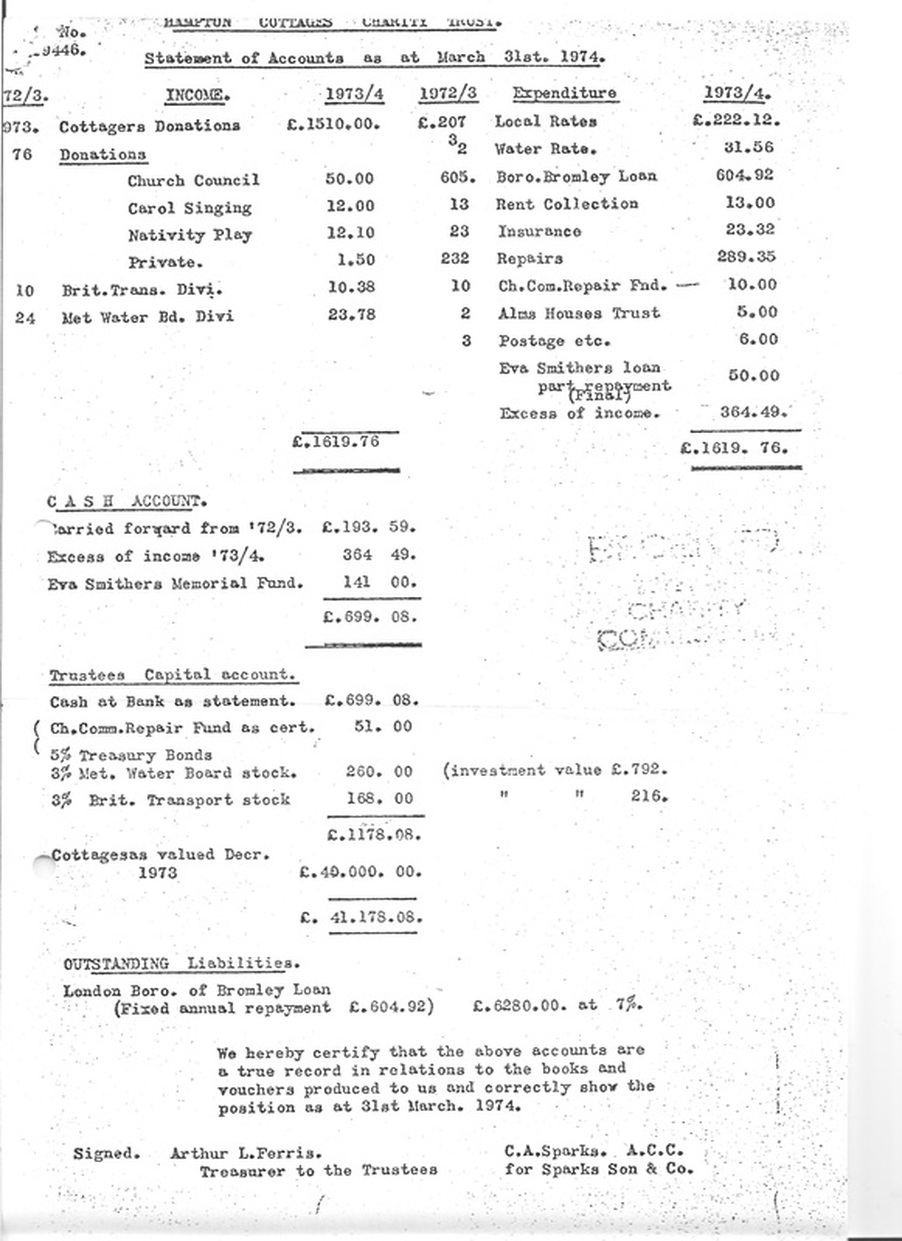
Financial Statement for the year ended 31st March, 1974 (Note Loan repayment to Eva Smithers)
======================================================
Miss. Ella Gibson
(late of No.10 Hampton Cottages)
Ella Gibson was a Hampton Cottages resident for nearly 37 years. She moved into No.10 in the latter part of 1972 and lived there until her death in August, 2009. Ella loved Knockholt and her cottage and in her will generously bequeathed her life savings for the benefit of Hampton Cottages Charity. We believe that she would have fully approved of her legacy being used as it was to fund the new roofs for Cottages 5 - 10. Ella's life story is very moving. She had never talked about her life before moving to Hampton Cottages to anyone (with the exception of Michael Leonard who was sworn to secrecy) so the whole story was not known until after her death.
This is Ella's Eulogy (written by Michael Leonard) and given at her funeral on Thursday 22nd October, 2009
Ella's Mother, Agnes Gibson, had her out of wedlock at the age of 17 years in a baby hostel in Edinburgh and registered her birth as being 8th October, 1925, at St. Andrew’s House, Edinburgh, but with no named Father. [Her father, she understood, was the son of an Italian Restaurant owner in that city, where her mother was employed as a waitress, but Ella never ascertained his name]. She was baptized by a Canon in the Scottish Episcopal Church in Edinburgh, and was later given a second “conditional” baptism in 1932 [aged 7 years] in St. Patrick’s RC Church, Edinburgh.
Her mother signed a piece of paper, [her “unofficial” adoption” papers] handing over her baby to friends who were prepared to help her out. They were a married couple, Mr and Mrs Frank Goldie, of 18, The Pleasance, then a slum of Edinburgh, who were Roman Catholic, and who already had a son, Frank, nine years older. Frank and Margaret [nee Doyle] Goldie did not have a “good marriage” and life was tough in this part of Edinburgh particularly at this time, during the Depression. They did what they could for her, Ella became the daughter that Frank senior had always wanted, which gave her a reasonable but deprived early childhood. She recalled having a china-headed doll that was her only worldly possession, to which she became much attached, but at the age of about six was made to give away to another child as she was “too old for it now”. She went to the local Catholic Primary school, run by the Sisters of Mercy, an Irish Order.
Mrs Margaret Goldie who was aware of her imminent death approached the head nun, Mother Theresa, asking for her to keep a close eye on Ella, after she was gone. She died aged 37of TB in 1934, and her natural Mother saw the death announcement in the newspaper, and called round one day soon after, with a son called “Francis” and possibly another child, and found Ella in the care of her “brother” Frank, then 18. Ella, at the age of 9 years detected that she was an “embarrassment” to her natural mother, who had since married and then had other children by her husband, who was clearly not aware of her existence. Her mother offered to try to get Ella “looked after” but Ella informed her mother, “not to worry about her”, and that she would “manage” and chose to remain with her “father and brother”, the two Frank Goldies.
At the age of 11, [1936] Mother Theresa, the Head of the school, was concerned that this girl was living with two adult men and felt that she should go into the Convent’s orphanage. Ella told me that she had never had any “problems” with either of these men. Both Frank Goldies were later called up for the War in 1939, when their home was given up.
The orphanage she found “a terrible place” and catered for girls of 14+. There were only “two other younger girls” there when she went there, and it was in about 1939 that Ella began to realise that she was “clever” and passed the “Qualifying” exam for further education very well, but because of her “background” was not considered suitable to go on! Public education then finished at 14 years only. There were two secondary schools in the area, the nearer one was the better one and was run on private lines but with “no money” would not take her. The farther one was inferior, and was considered too far away, so being 14 in 1939, she “left school”. A nun, Sister Mary Jerome was so disgusted that she left the Convent as a result of this treatment to Ella. Ella was employed in the orphanage and convent school for her keep and regularly had to do the banking for the Bursar, carrying substantial sums of money.
She was still at the orphanage at 17 [1942] when a friend called Catherine wanted to become a Carmelite nun, and Ella offered to accompany her to Falkirk to visit the Priory of 10 nuns. Ella was attracted by the peacefulness of the place, but it was Ella, who made an immediate impression on Mother Margaret, the Prioress there, who persuaded her to join them, but because of her illegitimacy, the matter had to be first referred to Rome. The decision came back that she could join only as a “lay sister” and could never be a “choir sister”, [a full nun], because of her birth, which meant that she would never be able to hold an “Office” or achieve a higher position such as “Prioress”. It meant that she would always have to do the menial tasks. She took her vows [2 to 4 years later] at about the time World War II ended.
For the next 20 years she worked in the Kitchen with two other Lay nuns, and the three routinely changed places. There was always a “cook” and a “second” [scullery maid] and she also hand-milked the goats. Gradually it was found that she was the better cook and assumed that role. The meals were entirely vegetarian and she developed a “nice little earner” for the Priory, making fudge and wedding cakes for sale, and won a prize in the Royal Highland Show for her cheeses.
After 20 years, the pressure of being constantly held back because of her birth, being unable to develop and progress further, always being put down [by one nun in particular], finally caused her to have a “depressive breakdown”, for which she was hospitalised for a short time in 1962. She then tried Office work but got no satisfaction from it.
In 1965 she was then into her 40’s, she finally saw the Archbishop regarding a “dispensation” when consideration was being given as to what to do with her. She chose to leave the Carmelite Order and left the Convent with the intention of making her way in the “outside” life embarking on a different career. She was interested in becoming a nurse, but again found that her illegitimacy and lack of education would only permit her to train for an SEN qualification, not the full SRN, but after starting her training, the hospital Authorities discovered that she had had a “breakdown” and refused to allow her to complete her training.
She then went to an Employment Agency in Glasgow and was offered two positions:
a] that of a “Scottish Nanny” in a family or
b] as a cook at the British Transport’s Management College at Woking, which offered a travel pass south!
So with £70 in her pocket and a suitcase of clothes, she came south and was offered a position as cook in the Kitchens, where she had to learn how to cook meat!
That Christmas she sent out a card to a Nurse friend, who she thought was working in Wales, but who was in fact attached to the Dreadnought Seamen’s Hospital, but was working at its offshoot, the Angus Home at Cudham, Kent, and they later met up. She introduced Ella to the Matron of Orpington Hospital, who applied for a reference from the Matron of the hospital in Scotland. The Scottish hospital Matron gave her a reference in such glowing terms that the Orpington Matron said that “they would take her anyway” and she started her training as an SRN. It was a 3 year course and the first time that her background had not penalized her. She lived in the Nurses home at Orpington Hospital, and had to put up with young girls slipping boyfriends into their bedrooms at night. This became too much for her, and she started enquiries about mortgages on her SRN pay, but found that she could not find anything to buy. She applied to the Council, but as a single woman she had too few “points” for rehousing.
One day on the Men’s ward at the Hospital, she mentioned that she could not get a mortgage on her income, and the only way she could get a Council House was to be an unmarried mother with at least one child. This got her immediate “offers of Help” from just about every patient there! A Knockholt churchwarden happened to be an in-patient there at the time and heard her express this predicament and on leaving hospital took her telephone number and invited her to tea on a day that the Knockholt Rector was also invited. This “interview” led to her being offered No.10 Hampton Cottages, in 1972, where for many years she then became the unpaid unofficial overseer of the frail in the other cottages. It was her stroke in 2003 that terminated this responsibility.
================================================================
"A History of Knockholt in the County of Kent"
by Professor Sir David Waldron Smithers
(ISBN 0951350048 / 9780951350041 / 0-9513500-4-8)
The almshouses were officially re-opened in late 1992 after the major refurbishment with a ribbon cutting ceremony presided over by Professor Sir. David Waldron Smithers of Ringfield, Knockholt whose family have provided generous support for the charity over the last 100 years. His"A History of Knockholt" is an excellent book and compulsory reading for the true "Knockholtian". It is the definitive publication on the history of our village. It seems that the book is no longer in print but there appear to be a few secondhand copies available. No guarantee, but you could try the following link:
http://www.bookfinder.com/dir/i/A_History_of_Knockholt_in_the_County_of_Kent/0951350048/
OBITUARY : Professor Sir David Smithers
Saturday, 5 August 1995
David Smithers was a Kentish man of many parts: author, scientist, rose grower, and one of the foremost cancer physicians for 30 years after the Second World War.
Smithers trained initially in radiology and became a pioneer of the new speciality of radiotherapy. He was appointed to the London University Chair of Radiotherapy at the Institute of Cancer Research in 1943, and in the same year became Director of the Radiotherapy Department at the Royal Marsden Hospital. He soon realised the potential medical uses of the new developments in physics, especially the production of artificial radioactive isotopes and high-energy X-ray beams.
With the medical physicist Val Mayneord he conceived the idea of a new centre for the application of nuclear physics to medicine. Frustrated by the inadequacy of the Royal Marsden site in Chelsea for his purposes, and the failure to purchase an adjacent site, David Smithers and his colleagues were instrumental in the acquisition of the grounds of the Downs Hospital, in Sutton, Surrey, where the new hospital was to be built. He worked tirelessly as Chairman of the Building Committee, and eventually the Surrey branch of the Royal Marsden Hospital was opened by the Queen in 1963.
Smithers's intention was that the hospital and its associated Institute of Cancer Research should eventually be sited entirely at Sutton, but many of his colleagues were opposed to moving so far from the centre of London. Nevertheless the success of the Surrey branch over the subsequent decades more than vindicated his vision. He built up research in both radiotherapy and radiobiology and his unit acquired an international reputation for training young clinicians and scientists from many countries. In collaboration with the cancer professor Gordon Hamilton-Fairley and experts of several other countries, he played a leading part in the advances which led to a spectacular increase in the cure rates of testicular cancer and Hodgkin's disease.
As a clinical scientist he concurred with the Austrian philosopher Karl Popper in the view that a theory must be testable by experiments designed to prove it false. He stressed in many writings that cancer is a disorder of organisation of the human body, rather than a defect of cells. In a controversial article in the Lancet in 1962 entitled "Cancer - an Attack on Cytologism", he castigated the concept of cancer as a disease in which people are devoured by their own cells gone wrong, and criticised much of the cancer research of the time as based on this false premiss and lacking direction, thereby gaining the opprobrium of many in his own institute. He did, however, appreciate the irony that the improvements in treatment with which he was associated were achieved largely by the destruction of cancer cells using radiation and the non- specific cell poisons of which he philosophically disapproved, while the simultaneous efforts in cancer immunology yielded very little fruit.
It was, however, much more as a clinician than as a scientist that Smithers excelled. He set an outstanding example to generations of young doctors passing through his unit in how to relate to patients as people. He stressed the importance of reading the case notes thoroughly before meeting the patient and insisted on having a photograph of the patient in the notes to remind him of the personal details; in this way he was always able immediately to gain the patient's confidence. This sensitive approach was linked with meticulous attention to the details of the treatment. He would tell his students more about his pleasure in the recovery and long life of individual patients than about the statistical results of his treatments.
David Smithers delighted in his family, his home and his beautiful garden in Knockholt, in Kent, where he grew roses and entertained his staff. His tea parties, when he took great pleasure in showing visitors his roses, accompanied by croquet on the lawn, provided his overseas visitors with a quintessential memory of England.
After retirement in 1974 he began a new career as an author. He wrote on a number of subjects mainly with a literary flavour, including Jane Austen, Dickens and his beloved Kent. In This Idle Trade (1989), a book written mainly about doctors as authors, he stressed the importance of a broadly based humanist education for recruits to the medical profession, and expressed his concerns about the danger that the modern intensive training of doctors may produce too narrow a specialist who is not able to take a broad view.
When he gained a richly deserved knighthood in 1969 he followed his father and grandfather as the third in successive generations of his family to be so recognised for public services.
J. M. Henk
David Waldron Smithers, radiotherapist: born 17 January 1908; Professor of Radiotherapy, London University 1943-73 (Emeritus); Director, Radiotherapy Department, Royal Marsden Hospital 1943-73; President, British Institute of Radiology 1946-47, Faculty of Radiologists 1959- 61; Kt 1969; married 1933 Gwladys Angel (died 1992; one son, one daughter); died 20 July 1995.
====================================================================================================================
Hampton Cottages Past Residents
Records of Residents have been kept since the early 1980's therefore this list only shows the names of past residents since that time many of whom have now sadly passed away.
No. 10
Miss Ella Gibson (1973-2009)
No. 9
Mrs. Joan Nock (Pre 1984 to 2004)
No. 8
Miss. Ethel Clifton (pre 1984)
Mrs. Pamela Couchman (to 2007)
No. 7
Mrs. Peacock
Mrs. Betty Bowen
Miss. Joyce Nessling
Rev. Wallace Mason (to 2003)
No. 6
The Misses Ada & Edie Brookwell (pre 1984 to 2006)
No. 5
Mr. & Mrs. Horace & Grace Martin
Mr. Patrick Healy (to 2003)
No. 4
Mrs. Ann Edgar (pre 1984)
Mrs. Ethel Webb (1995)
Mrs. Dorothy Abels (1999 – 2007)
No. 3
Mrs. Nan Crick (to 1990)
Mrs. Gladys Coppock (to 1997)
No. 2
Miss. Butcher
Mrs. Brain
Mr. George Relf (1995)
Mr. & Mrs. Frank and Iris Ward (1999 - 2007)
Mr. Norman Steptowe (to 2013)
No.1
Mr. Alec Eder
Mrs. Helen Gasson (1995)
Mrs. Louise Williams (1998)
Mrs. Jackie Grimaldi (2000)
Mrs. Marie Haynes (to 2012)
(NB: Dates may not be entirely accurate).
============================================================================================================================
The following cutting is reproduced here with the kind permission of
St. Katharine's Knockholt Parish News.
This article was first published in St. Katharine's Parish News August 2010. For details of this monthly publication contact the Editor on 01959 532467.
(With apologies for the poor reproduction)

